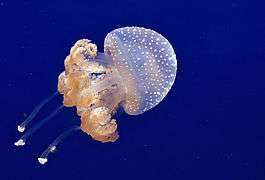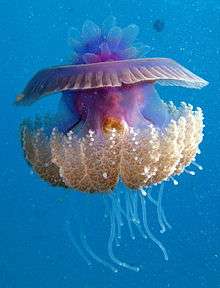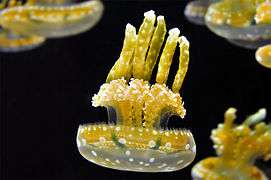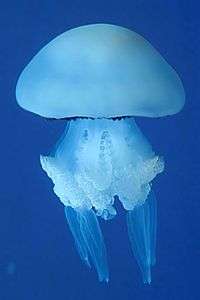Rhizostomae
Rhizostomae or Rhizostomeae is an order of jellyfish. Species of this order have neither tentacles nor other structures at the bell's edges. Instead, they have eight highly branched oral arms, along which there are suctorial minimouth orifices. (This is in contrast to other scyphozoans, which have four of these arms.) These oral arms become fused as they approach the central part of the jellyfish. The mouth of the animal is also subdivided into minute pores that are linked to coelenteron.
| Rhizostomae | |
|---|---|
 | |
| Phyllorhiza punctata | |
| Scientific classification | |
| Kingdom: | Animalia |
| Phylum: | Cnidaria |
| Class: | Scyphozoa |
| Subclass: | Discomedusae |
| Order: | Rhizostomeae Cuvier, 1799 |
Edible jellyfish
Jellyfish species fished on a commercial basis for human consumption (both as a delicacy and for use in traditional medicine) are all from this order[1] and include members of the families Catostylidae, Lobonematidae, Rhizostomatidae and Stomolophidae.[2][3][4] The jellyfish are typically dried and/or salted.[1] In China, which was the first country documented to use jellyfish as food, this has been practiced at least since the year 300 CE,[1] but they are also commonly consumed in Japan (the largest consumer of jellyfish today), Korea and southeast Asia.[3][4] Several countries outside Asia have also started catching and exporting these in recent decades.[1]
Taxonomy
As of 2007, there were 92 recognized extant species in Rhizostomeae.[5] These belong in the following families:[5][6]
- Sub-order Daktyliophorae
- Family Catostylidae Gegenbaur, 1857 -- 7 genera
- Family Lobonematidae Stiasny, 1921 -- 2 genera
- Family Lychnorhizidae Haeckel, 1880 -- 3 genera
- Family Rhizostomatidae Cuvier, 1799 -- 4 genera
- Family Stomolophidae Haeckel, 1880 -- 1 genus
- Sub-order Kolpophorae
- Family Cassiopeidae Agassiz, 1862 -- 1 genus
- Family Cepheidae Agassiz, 1862 -- 5 genera
- Family Mastigiidae Stiasny, 1921 -- 5 genera
- Family Thysanostomatidae Gegenbaur, 1857 -- 1 genus
- Family Versurigidae Gegenbaur, 1857 (empty taxa)
- Cassiopea andromeda, a Cassiopeidae (upside-down jellyfish)
- Catostylus mosaicus, a Catostylidae
 Cephea cephea, a Cepheidae
Cephea cephea, a Cepheidae Mastigias papua, a Mastigiidae
Mastigias papua, a Mastigiidae
 Stomolophus meleagris, a Stomolophidae
Stomolophus meleagris, a Stomolophidae- Thysanostoma loriferum, a Thysanostomatidae
References
| Wikimedia Commons has media related to Rhizostomeae. |
| Wikispecies has information related to Rhizostomeae |
- López-Martínez; and Álvarez-Tello (2013). The jellyfish fishery in Mexico. Agricultural Sciences 4(6A): 57-61.
- Miura; Miura; and Park (2006). Collagen as the Major Edible Component of Jellyfish (Stomolophus nomural). Journal of Food Science 48(6): 1758–1760.
- Kitamura; and Omori (2010). Synopsis of edible jellyfishes collected from Southeast Asia, with notes on jellyfish fisheries. Plankton Benthos Res 5(3): 106–118.
- Omori; and Kitamura (2004). Taxonomic review of three Japanese species of edible jellyfish (Scyphozoa: Rhizostomeae). Plankton Biol. Ecol. 51(1): 36–51.
- Daly, Brugler, Cartwright, Collins, Dawson, Fautin, France, McFadden, Opresko, Rodriguez, Romano & Stake (2007). The phylum Cnidaria: A review of phylogenetic patterns and diversity 300 years after Linnaeus. Zootaxa 1668: 127–182
- "Rhizostomeae". WoRMS. World Register of Marine Species. Retrieved 4 August 2012.